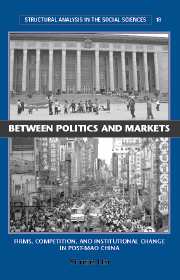Book contents
- Frontmatter
- Contents
- Tables and Figures
- Acknowledgments
- Introduction: Economic Market and Political Market
- 1 Chinese Industrial Enterprises: A Bird's-Eye View
- 2 Central Planning and Its Decline
- 3 The Rugged Terrain of Competition
- 4 Referee as Player: Menaces and Opportunities for Industrial Firms
- 5 Erosion of Authority Relations: A Tale of Two Localities
- 6 Favor Seeking and Relational Constraints
- 7 Competition, Economic Growth, and Latent Problems
- Conclusion
- Appendix A Statistical Data Sources
- Appendix B Methodological Note on Case Studies
- Bibliography
- Index
1 - Chinese Industrial Enterprises: A Bird's-Eye View
Published online by Cambridge University Press: 15 July 2009
- Frontmatter
- Contents
- Tables and Figures
- Acknowledgments
- Introduction: Economic Market and Political Market
- 1 Chinese Industrial Enterprises: A Bird's-Eye View
- 2 Central Planning and Its Decline
- 3 The Rugged Terrain of Competition
- 4 Referee as Player: Menaces and Opportunities for Industrial Firms
- 5 Erosion of Authority Relations: A Tale of Two Localities
- 6 Favor Seeking and Relational Constraints
- 7 Competition, Economic Growth, and Latent Problems
- Conclusion
- Appendix A Statistical Data Sources
- Appendix B Methodological Note on Case Studies
- Bibliography
- Index
Summary
Industry as defined by the Chinese government includes manufacturing, mining, and production and supply of electricity, gas, water, and steam. It is China's largest economic sector. Its leading position was established by the government's concentrated effort to industrialize the economy during the three decades after the communist revolution. In 1949 the industrial sector contributed less than 13% of China's national income (GJTJJa 1983: 24). In 1978 it accounted for 44.3% of the country's gross domestic product (GDP); in 1998 its share remained at 42.2% despite a significant increase in the contribution from the tertiary sector during the preceding two decades (GJTJJa 1999: 13).
The main avenue of state-engineered industrialization in the postrevolution era was central planning, and the main vehicles that carried it through were state enterprises. Since 1978, however, the central planning system has declined. The development of the state sector economy has also changed course toward markets. But state enterprises have been overtaken by nonstate enterprises, especially those formed in the reform, as the leading force of marketization. Indeed, many state enterprises have demonstrated a slow pace in participating in market-oriented economic activities, faced great difficulties in competition, and experienced steady deterioration in performance. To see how and why these changes have taken place, it is necessary to take a bird's-eye view of the transforming landscape of the industrial sector.
- Type
- Chapter
- Information
- Between Politics and MarketsFirms, Competition, and Institutional Change in Post-Mao China, pp. 24 - 46Publisher: Cambridge University PressPrint publication year: 2001

